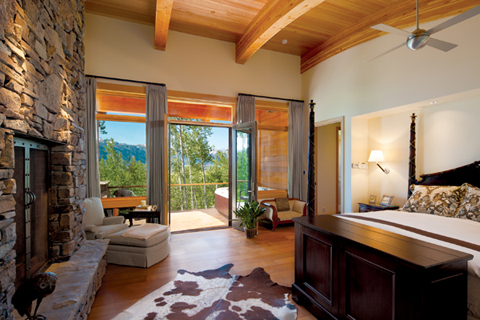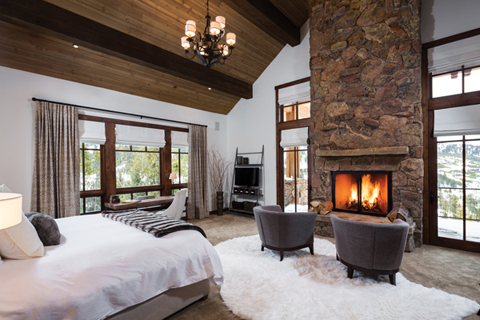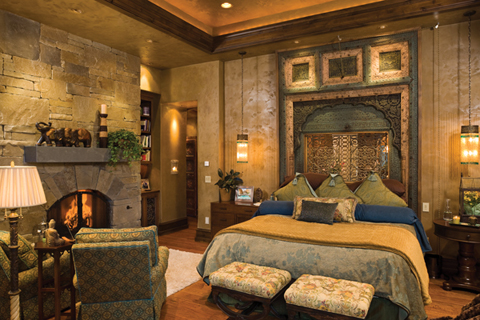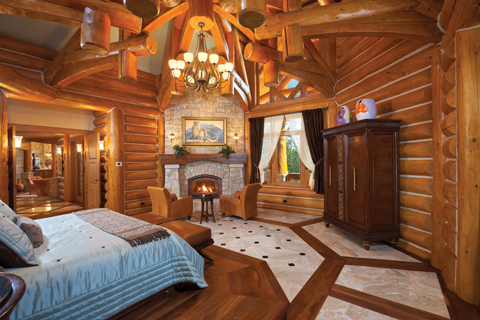We often pour energy and creativity into the “public” rooms in our houses: great rooms, kitchens, and entertainment rooms. But we should reserve some of that care and effort to create an idyllic environment in our most personal rooms: the bedrooms.
Resist the temptation to make your bedroom multifunctional: studies show that we sleep better when we reserve our bedrooms for relaxation, not work. From layout to furnishings, your bedroom designs should reflect your personality while providing a serene escape at the end of the day.
Location, Location, Location
During the design phase, there are multiple factors that go into bedroom planning. A first (and critical) decision is where to put the bedrooms in your home. “Lifestyle changes can occur any time, so locating the master bedroom on the first floor is not something that only people of retirement age should consider,” says Richard Titorenko, sales representative for Coventry Log Homes in Woodsville, New Hampshire.

CTA Architects and Stewart Construction/photo © Karl Neumann
Even with the master bedroom on the main floor, you may want to locate children’s bedrooms or guest rooms on the second floor, away from the bustle and activity of the public spaces in your home. A lower level bunkroom might be ideal for children and their friends to get some space of their own without raising the noise level in the rest of the house.
“There are code considerations—each bedroom is required a means of egress, so plan appropriately for a compliant window unit or door unit,” advises Lynda Tompkins, principal at Timberhaven Log Homes in Lewisburg, Pennsylvania. Tompkins notes that you have to plan for where to place windows and doors in relation to not only exterior wall space, but also furniture placement and closet locations. Large windows that let in an abundance of natural light are wonderful, but don’t forget to place them judiciously to ensure privacy. Keep climate in mind, too. A bedroom facing west may heat up uncomfortably on summer evenings, but window dressings can help you address both privacy and temperature.
Also, consider what you want to look at before you close your eyes at night and when you first wake in the morning. Do you want to drift off to a starlit view of your property, or wake to the sunrise? Do you want to enjoy your morning coffee on a private master bedroom deck, or enjoy a picture window framing a mountain tableau?

Photo © Karl Neumann
Don’t Neglect the Details
“One thing people don’t think about is socket locations and how many to include,” says Sarah Smith of Blue Ridge Log Cabins in Campobello, South Carolina. Adding electrical sockets later isn’t always easy, so it is important to think in advance about where you’ll want the television, lamps, fans, and other electrical items, especially in this day and age when we’re so connected to technology. Fireplaces are always popular in master bedrooms, not just for ambience but as a heat source. Electric, pellet, and gas options are often a good alternative to wood-burning fireplaces if you prefer not to haul logs into your bedroom. Also consider installing radiant heat in the master bedroom and bath for added warmth on chilly winter mornings.
Don’t skimp on storage. Even if you envision using your home as a vacation getaway, it can’t hurt to design in plenty of closet space, since it can be a challenge to add storage later. Bunkrooms can incorporate under-bunk drawers for added storage that doesn’t take up much space; window seats can double as linen storage.

Locati Architects and SBC Construction/photo © Karl Neumann
Get Creative with Décor
Your décor choices should lend a mood to your bedroom. If you crave a peaceful oasis, you might want to use a neutral palette with soft lighting. Or create a den-like retreat with warm autumnal tones and a stone fireplace for ambiance.
The décor is an avenue for you to make your bedroom truly reflect your personality, whether you’re going for warm and cozy or spacious and airy. Even the most rustic bedroom can bring in touches of Old Hollywood glamour or European chic by using furnishings and light fixtures that reflect the aesthetic you are going for. You can also play off your environment to inspire your bedroom themes. A wine country home might be well suited to Mediterranean décor, while a lakefront home might lend itself to a casual beach theme.
“People are moving toward color in log homes,” says Smith. “To make a big change you don’t have to do a lot—just painting the trim can make a big difference.” An accent wall painted in a vibrant red or soft blue can give the room a completely new feel. Bold, bright hues inject a shot of energy into a room. Neutral shades can be livened up with textures and patterns or by adding in colorful accessories like pillows and throw blankets that can be rotated with the season.

John Hendricks Architects, Sandau Builders, and Tammie Ladd Design/photo © Karl Neumann
Natural materials are more popular than ever and they are right at home in a log or timber frame home, so use brick, stone, and wood liberally to capitalize on that rustic appeal. “We did a whole wall out of poplar bark,” says Smith, noting that you can use any kind of bark, or even cedar shake, on an accent wall.
Your choice of furnishings and accessories can range from classic to contemporary, even in a traditional log home. “Lately we’re seeing a lot of rustic industrial furniture,” says Smith. “People are mixing rustic and modern, bringing in weathered wood.” Materials like concrete and recycled metals contrast beautifully with reclaimed wood, for furnishings with character that hint at their previous life. Recycled barn doors on a track instead of traditional closet doors? Why not?
In today’s busy world a bedroom should be a true retreat from life’s constant demands. Create a bedroom that will deliver you from stress and offer a peaceful sanctuary that will allow you to relax and unwind right at home.

